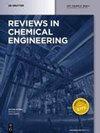Uncertainty quantification and propagation in atomistic machine learning
IF 6.6
3区 工程技术
Q1 ENGINEERING, CHEMICAL
引用次数: 0
Abstract
Machine learning (ML) offers promising new approaches to tackle complex problems and has been increasingly adopted in chemical and materials sciences. In general, ML models employ generic mathematical functions and attempt to learn essential physics and chemistry from large amounts of data. The reliability of predictions, however, is often not guaranteed, particularly for out-of-distribution data, due to the limited physical or chemical principles in the functional form. Therefore, it is critical to quantify the uncertainty in ML predictions and understand its propagation to downstream chemical and materials applications. This review examines existing uncertainty quantification (UQ) and uncertainty propagation (UP) methods for atomistic ML under the framework of probabilistic modeling. We first categorize the UQ methods and explain the similarities and differences among them. Following this, performance metrics for evaluating their accuracy, precision, calibration, and efficiency are presented, along with techniques for recalibration. These metrics are then applied to survey existing UQ benchmark studies that use molecular and materials datasets. Furthermore, we discuss UP methods to propagate uncertainty in widely used materials and chemical simulation techniques, such as molecular dynamics and microkinetic modeling. We conclude with remarks on the challenges and opportunities of UQ and UP in atomistic ML.原子机器学习中的不确定性量化与传播
机器学习(ML)为解决复杂问题提供了有前途的新方法,并越来越多地应用于化学和材料科学。一般来说,机器学习模型使用通用的数学函数,并试图从大量数据中学习基本的物理和化学。然而,由于功能形式中的物理或化学原理有限,预测的可靠性往往不能得到保证,特别是对于超出分布的数据。因此,量化机器学习预测中的不确定性并了解其在下游化学和材料应用中的传播至关重要。本文综述了概率建模框架下原子机器学习中现有的不确定性量化(UQ)和不确定性传播(UP)方法。我们首先对UQ方法进行了分类,并解释了它们之间的异同。接下来,介绍了评估其准确性、精密度、校准和效率的性能指标,以及重新校准的技术。然后将这些指标应用于使用分子和材料数据集的现有UQ基准研究。此外,我们讨论了在广泛使用的材料和化学模拟技术中传播不确定性的UP方法,如分子动力学和微动力学建模。最后,我们对原子机器学习中UQ和UP的挑战和机遇进行了评论。
本文章由计算机程序翻译,如有差异,请以英文原文为准。
求助全文
约1分钟内获得全文
求助全文
来源期刊

Reviews in Chemical Engineering
工程技术-工程:化工
CiteScore
12.30
自引率
0.00%
发文量
37
审稿时长
6 months
期刊介绍:
Reviews in Chemical Engineering publishes authoritative review articles on all aspects of the broad field of chemical engineering and applied chemistry. Its aim is to develop new insights and understanding and to promote interest and research activity in chemical engineering, as well as the application of new developments in these areas. The bimonthly journal publishes peer-reviewed articles by leading chemical engineers, applied scientists and mathematicians. The broad interest today in solutions through chemistry to some of the world’s most challenging problems ensures that Reviews in Chemical Engineering will play a significant role in the growth of the field as a whole.
 求助内容:
求助内容: 应助结果提醒方式:
应助结果提醒方式:


